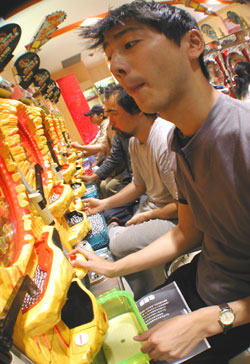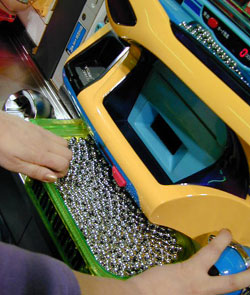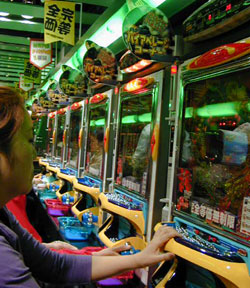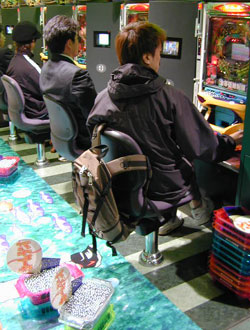The Pachinko Player
Usually the Captain finds that a mere six or seven morning lagers is sufficient to get him ready behind his typewriter before he begins tapping out his daily copy. Of course, not everyone can exist in such a structured work environment.
 This week he is chatting with a pachinko player who once earned a sizable income entirely by playing with those bouncing silver balls. Get ready, readers, the Captain is going to teach you how to win some serious cash.
This week he is chatting with a pachinko player who once earned a sizable income entirely by playing with those bouncing silver balls. Get ready, readers, the Captain is going to teach you how to win some serious cash.
His slender and tall frame quickly slips down one alleyway after another just outside the West Exit of Yokohama Station. He scans the names of the pachinko parlors seemingly situated on every corner.
The hunt is on.
He keeps moving, paying no mind to the milling crowds or the sticky pavement on this summer afternoon, and enters one of the gaudy establishments. But after a quick scan of the floor map he shakes his head and immediately darts out the back door.
A few yards further down the alley, he steps into the front door of the parlor named Popeye. After shuffling down one aisle and making a turn to the left, he pauses and then breaks into a wide grin.
He sees a hanemono, or "wing-type," machine.
"There are so many machines to choose from but I only use hanemono," says Kenichiro Nishi of his pachinko machine of choice in the world of - what amounts to - upright pinball gambling.
Nishi, 30, is a pachinko expert. His strategy for success revolves around money management and riding the wings of the hanemono. It has served him well during his years of attempting to wrestle what he can from this huge industry.
The theory is very basic: invest low amounts initially and don't get greedy.
Nishi settles down behind the machine and begins feeding 500-yen coins into the slot at the top. Staring straight forward, he turns the machine's dial and dozens of metal balls begin shooting upward and tumbling downward.
 The goal for the player is to launch the balls up so that they fall down through the mazes of nails and into certain slots or gates that can yield many more balls.
The goal for the player is to launch the balls up so that they fall down through the mazes of nails and into certain slots or gates that can yield many more balls.
The exact payouts are controlled by computer. For the hanemono, there are three gates at the bottom of the machine, one on either side and one in the middle. Balls falling into these gates cause the pair of wings situated near the top to flap open. When that happens subsequent balls can enter a special chamber whereby the payout is 400 yen multiplied by a "round," or oatari, of either 1, 5, or 15 per ball. The value of the round is up to the computer chip in the machine.
The Popeye parlor, where the sailor man's smiling image is not in short supply, is a chaotic sea of activity. Throbbing dance music is pumped at a fast pace over the rapid-fire clinging of the steel balls into the metal trays below each machine. Ashtrays fill to side of nearly every machine as barkers make nearly inaudible screams into the PA system to encourage players to keep playing. Blow me down, indeed.
These distractions have no impact on Nishi. "My eyes are always focused on the machine," he says. "If I cannot concentrate because of my mood, I'll leave."
The pachinko business in Japan is massive. Tallies for 2004 reveal that players sent nearly 30 trillion yen worth of balls (at a rate of 2.5 yen per ball) bouncing through the industry's machines. Maruhan, Japan's largest machine maker, had sales of 1.2 trillion yen for the fiscal year ending March 31, 2005. For comparison, Japan's leading broadcasting station, NHK, generated half that amount over the same period.
Though often linked to gangster activity and political corruption, this form of gambling is technically legal. Converting winning balls back to cash is done via a middleman at a satellite office away from the parlor. Given that gambling not controlled by the government in Japan is illegal, this additional step makes the swap back to cash legal. For those not interested in cash, patrons can exchange balls for cigarettes, cosmetics or other luxury items on the parlor premises.
 On a good day, Nishi says that a 2,000-yen initial outlay can yield roughly 10,000 yen after two hours of playing. Of course, that is only if he wins. He figures that this investment is wiped out half of the time. On those days, he goes home and starts again the next day.
On a good day, Nishi says that a 2,000-yen initial outlay can yield roughly 10,000 yen after two hours of playing. Of course, that is only if he wins. He figures that this investment is wiped out half of the time. On those days, he goes home and starts again the next day.
Ten years ago the machines were generally not controlled by computers. Instead, the parlor owners alternately "adjusted" the slant of the nails just a bit to make certain machines more lucrative than others. Even in this computer-dominated pachinko age, players can be seen lined up in front of parlors seeking machines rumored to be "hot."
Nishi was schooled in pachinko's analog days. He discarded guesses on which machines might pay out and honed his skills at operating the dial that controls the release of the balls. Over time, he realized that each maker's machine was different and adjusted accordingly.
Nishi always began with 300 yen in those days. Like today, he could turn that amount into 10,000 yen in two hours. The key was that the oatari was set only to a non-computer-controlled 15, hence the smaller initial investment needed to return the same amount.
The 10,000-yen mark is a milestone for Nishi. He has conditioned himself to never continue playing if he surpasses and then falls 10% below that mark. Likewise, his largest jackpot was 15,000 yen.
There were 2 two-year periods, just after and during his schooling at the prestigious Keio University, where his average monthly income was 150,000 yen. Nishi figures he spent an average of 20 hours a week in the parlors. Today a non-smoker, he sometimes accepted cartons of cigarettes at the parlors in lieu of cash so that he could puff as he played.
"I saw guys pounding the machines with their fists and screaming," he remembers of some of the other clientele.
While at Keio, his routine began once classes finished. His first stop was to the local liquor shop for a few cups of oolong-hai (pre-mixed shelf liquor of Chinese tea and grain alcohol). Freshly emboldened, he'd then head for the parlor.
To call him a pachi puro (pachinko professional) at that time would have been a stretch, however, given that he was living with his parents and spending his gains on comic books and computer games. (Stories of a pachi puro supporting his family are not uncommon in Japan.)
 Other machines besides hanemono exist. For example, the pachi suro (pachinko slot) machines are coin-based games of revolving cylinders similar to standard slot machines. But the windfalls are not as steady, Nishi says.
Other machines besides hanemono exist. For example, the pachi suro (pachinko slot) machines are coin-based games of revolving cylinders similar to standard slot machines. But the windfalls are not as steady, Nishi says.
Nishi's theories on pachinko are not from just from his experience. He has spent years cross-checking his results with the advice given in Ryozanpaku manuals - pachinko bibles that contain tips from other pachinko whiz kids on how to beat the odds.
Armed with these magazines and inspired by his pachinko-playing father, who, as Nishi says, "is a lousy player because he doesn't control his money," Nishi began hitting the dusty pachinko dens at the age of 14. (Unlike restrictions on tobacco and alcohol use, anyone can play pachinko in Japan.)
His passion for the game has always been rooted in the recreation aspect of it. He never worried about becoming an addict, even in his semi-pro days. He maintains this stance today.
Now working as a full-time elementary school teacher, his approach to the game, which he now plays once a month, is the same.
"Everytime I enter the pachinko parlor," he says, "I do so with confidence in myself."
Note: Kei Takahashi contributed to this report from the Yokohama Bureau.

